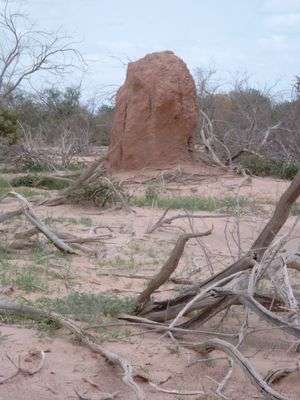Tiger bush




Tiger bush or brousse tigrée is a patterned vegetation community and ground consisting of alternating bands of trees, shrubs, or grass separated by bare ground or low herb cover, that run roughly parallel to contour lines of equal elevation. The patterns occur on low slopes in arid and semi-arid regions,[1] such as in Australia, Sahelian West Africa, and North America.[2][3]
Due to the natural water harvesting capacity, many species in tiger bush usually occur only under a higher rainfall regime.
Formation
The alternating pattern arises from the interplay of hydrological, ecological, and erosional phenomena. In the regions where tiger bush is present, plant growth is water-limited - the shortage of rainfall prevents vegetation from covering the entire landscape. Instead, trees and shrubs are able to establish by either tapping soil moisture reserves laterally or by sending roots to deeper, wetter soil depths. By a combination of plant litter, root macropores, and increased surface roughness, infiltration into the soil around the base of these plants is enhanced. Surface runoff arriving at these plants will thus likely to become run-on, and infiltrate into the soil.
By contrast, the areas between these larger plants contain a greater portion of bare ground and herbaceaous plants. Both bare soil, with its smoother surface and soil crusts, and herbaceaus plants, with fewer macropores, inhibit infiltration. This causes much of the rainfall that falls in the inter-canopy areas to flow downslope, and infiltrate beneath the larger plants. The larger plants are in effect harvesting rainfall from the ground immediately up-slope.[4]
Although these vegetation patterns may seems very stable through time, one should note that such patterning requires specific climatic conditions. For instance, a decrease in rainfall is able to trigger patterning in formerly homogeneous vegetation within a few decades.[5]
More water will infiltrate at the up-slope edge of the canopies than down-slope.[6] This favours the establishment and growth of plants at the up-slope edge, and mortality of those down-slope. Differences in growth and mortality across the vegetation band result in the band moving gradually upslope.[7][8][9]
Tiger bush never develops on moderate to steep slopes, because in these cases surface runoff concentrates into narrow threads or rills instead of flowing over the surface as sheet flow. Sheet flow distributes water more evenly across a hillslope, allowing a continuous vegetation band to form.
The exact roles and importance of the different phenomena is still the subject of research.
Exploitation and conservation
The woody plants which make up tiger bush are used for fire wood and as a source of foliage for grazers. The extensive loss of tiger bush around Niamey, Niger, now threatens local giraffe populations. In neighbouring Burkina Faso, the tiger bush vegetation is also declining.
References
- ↑ d'Herbès, Jean-Marc; Valentin, Christian; Tongway, David J.; Leprun, Jean-Claude (2001). "Banded Vegetation Patterns and Related Structures". In Tongway, David J.; Valentin, Christian; Seghieri, Josiane. Banded vegetation patterning in arid and semiarid environments: Ecological Processes and Consequences for Management. Ecological Studies. 149. New York: Springer. pp. 1–19. ISBN 978-1-4613-0207-0.
- ↑ Deblauwe V., Barbier N., Couteron P., Lejeune O. & Bogaert J. (2008). The global biogeography of semi-arid periodic vegetation patterns. Global Ecol Biogeogr, 17, 715-723.
- ↑ Valentin, Christian (2004). "Brousse tigrée". In Goudie, A.S. Encyclopedia of Geomorphology. pp. 102–103.
- ↑ Tongway, D. J. & Ludwig, J. A. (2001) Theories on the origins, maintenance, dynamics, and functioning of banded landscapes. Banded vegetation patterning in arid and semiarid environments : ecological processes and consequences for management (ed. by D.J. Tongway & C. Valentin & J. Seghieri), pp 20-31. Springer-Verlag, New York.
- ↑ Barbier N., Couteron P., Lejoly J., Deblauwe V. & Lejeune O. (2006). Self-organized vegetation patterning as a fingerprint of climate and human impact on semi-arid ecosystems. J Ecol, 94, 537-547.
- ↑ Galle, S., Brouwer, J. & Delhoume, J. P. (2001) Soil water Balance. Banded vegetation patterning in arid and semiarid environments : ecological processes and consequences for management (ed. by D.J. Tongway & C. Valentin & J. Seghieri), pp 77-104. Springer-Verlag, New York.
- ↑ Worrall, G. A. (1959) The Butana grass patterns. Journal of Soil Science, 10, 34-53.
- ↑ Montaña, C. (1992) The colonization of bare areas in two-phase mosaics of an arid ecosystem. Journal of Ecology, 80, 315-327.
- ↑ Deblauwe, V., et al. (2012). Determinants and dynamics of banded vegetation pattern migration in arid climates. Ecological Monographs, 82(1), 3-21.
